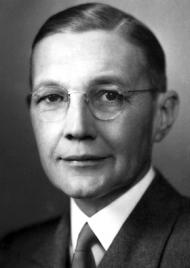Edwin Mattison McMillan (September 18, 1907 – September 7, 1991) was an American physicist and Nobel laureate credited with being the first ever to produce a transuranium element. He shared the Nobel Prize in Chemistry with Glenn Seaborg in 1951.
Biography
McMillan was born in Redondo Beach, California, but his family moved to Pasadena the following year. He attended some of the public lectures at the California Institute of Technology as a high school student and began his studies there in 1924. He did a research project with Linus Pauling as an undergraduate and received his Bachelor of Science degree in 1928 and his Master of Science degree in 1929, both from the California Institute of Technology.
He then took his Doctor of Philosophy from Princeton University in 1932 for the thesis: "Deflection of a Beam of HCI Molecules in a Non-Homogeneous Electric Field" under the supervision of Edward Condon.
He joined the group of Ernest Lawrence at the University of California, Berkeley upon receiving his doctorate, moving to the Berkeley Radiation Laboratory when it was founded at Berkeley in 1934.
His experimental skills lead to the discovery of oxygen-15 with M. Stanley Livingston and beryllium-10 with Samuel Ruben
In 1940 he and Philip Abelson created neptunium, while conducting a fission experiment of uranium-239 with neutrons, using the cyclotron at Berkeley. The newly found isotope of neptunium was created by absorption of neutron into the uranium-239 and a subsequent beta decay. McMillan understood the underlying principle of the reaction and started to bombard the uranium-239 with deuterium to create the element 93. He moved to the radar research at the Massachusetts Institute of Technology and Glenn T. Seaborg finished the work.
In World War II, he was involved in research on radar at MIT in Cambridge, Massachusetts, sonar near San Diego, and about November 1942 was recruited to the Manhattan Project at the Los Alamos Laboratory, being involved in the initial selection of Los Alamos and in implosion research.
After World War II, he rejoined the Berkeley Radiation Laboratory, and became head of the institute after the death of Ernest Lawrence in 1958.
In 1945, independently of Vladimir Veksler's 1944 work, he developed ideas for the improvement of the cyclotron, leading to the development of the synchrotron. The synchrotron was used to create new elements at Berkeley Radiation Laboratory extending the periodic system of elements far beyond the 92 elements known before 1940.
With Glenn T. Seaborg, he shared the Nobel Prize in Chemistry in 1951 for "discoveries in the chemistry of the transuranium elements." This medal is currently held at the National Museum of American History, a division of The Smithsonian.
In 1946, he became a full professor at Berkeley, and in 1954 he was appointed associate director of the Lawrence Radiation Laboratory, being promoted to director in 1958, where he stayed until his retirement in 1973.
He was elected to the National Academy of Sciences in 1947, serving as its chairman from 1968 to 1971. He received the Atoms for Peace Award in 1963 (with Vladimir Veksler).

